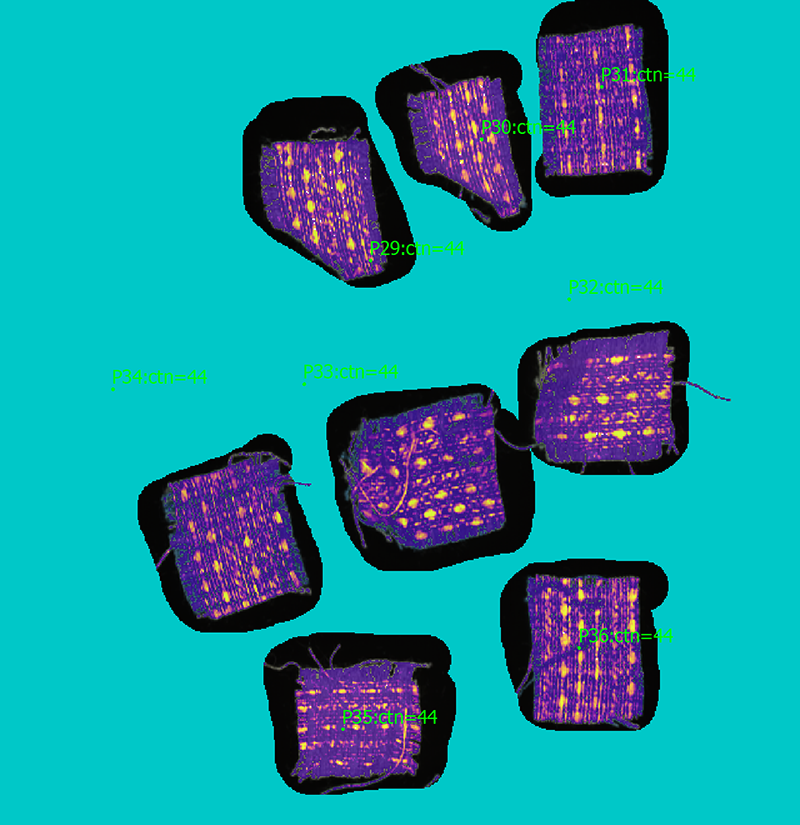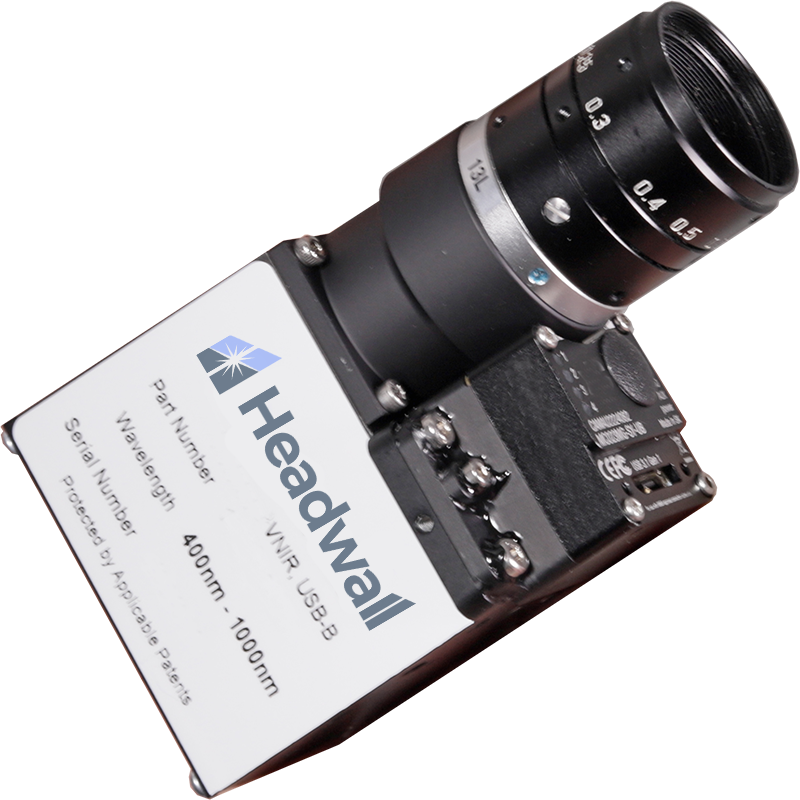Brix Prediction Using Hyperspectral Imaging
RAPID, NON-DESTRUCTIVE ANALYSIS AND IMPROVED PRODUCTIVITY

Approximately 70 million tons of oranges are produced per year worldwide. About a third of the total tonnage is processed, with the rest being consumed as fresh fruit.1
Sweetness, or the concentration of soluble solids is of particular importance to orange processors. Commonly reported in degrees Brix, it is a key quality factor in assessing the grade of the product delivered into the processing facility. Results are used to calculate the value of the delivered fruit and are directly tied to costs and profitability. The measurement traditionally requires obtaining a representative sample from the delivered load and then juicing and analysis using a laboratory refractometer. However, the process of obtaining results can be slow and labor intensive.
Hyperspectral imaging (HSI) offers a solution to this challenge. An HSI system such as the MV.X VNIR used here can rapidly collect highly resolved spectral data from a load of oranges passing under the sensor. Processing this data in real time and applying statistical analysis algorithms developed by Headwall, the system delivers to the user a predicted °Brix value at the end of the scan.
Value of Spectral Imaging:
- No Sampling
- No Sample Prep
- Real-Time Results
- Optimize Workflows
- Enables Digital Solutions
- Advanced Analytics
Headwall’s award-winning Hyperspec® MV.X system is designed to streamline the extraction of actionable information from hyperspectral data. Highly intuitive software enables the user to easily create and improve the prediction models and deliver real-time results.



For the purpose of this study, a Headwall VNIR (400-1000nm) HSI system was used to scan Hamlin oranges from Florida. To obtain the reference values, each of the oranges were juiced, and °Brix was measured using a Cole-Parmer® EW-81150-48 digital refractometer. The refractometer data was employed to train a regression model for prediction of °Brix based on hyperspectral data.
A classification model was created by training the data processing software to recognize the differences between an orange and any foreign areas. Each orange was designated as an object and the oranges were associated with the respective reference °Brix values. A regression analysis model was created and optimized using spectra from the test sample.
Based on this model, Headwall’s software generated a prediction map where every pixel is assigned a °Brix value. The average of all the pixels in each object resulted in the calculated °Brix for each orange. A plot of the measured versus calculated °Brix demonstrates a good level of agreement between the methods with an R2=0.98.
This example, while based on a small data set and produced in a controlled environment, demonstrates a proof of principle and provides a glimpse into the great potential value of HSI in orange-processing operations.
Want to know more?
More Application Notes

Cayenne and Oregano
Spectral classification via the perClass Mira Software makes the task of assessing herb and spice quality less challenging by providing a clear indication of the presence of adulterants, and also provides a workflow of detecting unknown adulterants and additives.

Sorting Textiles for Recycling
Of the many efforts of conservation and reduction of waste, textiles remain one of the greatest challenges. The United States EPA estimates that of the 25 billion pounds of post-consumer textile waste recycled, only 15% is recycled and repurposed, while

Foreign Object Detection in Cheese
When large blocks of cheese are unwrapped, cut, and repackaged, processors must inspect the cheese for any remaining debris. Clear or even tinted plastic is notoriously difficulty to spot by eye or conventional inspection methods. Recalls are costly and damaging

Surface Moisture Estimation of Bread: Rapid, Non-Contact Measurement
A significant challenge for industrial production of baked goods is monitoring moisture content. This attribute is
a crucial measurement at all stages of production. Raw materials can contain water that can cause clumping or degradation of products during storage, lowering

Non-Contact Prediction of Blueberry Brix
Headwall’s hyperspectral imaging (HSI) technology, blueberries can be inspected based on their condition, and their Brix value can be predicted, allowing for a non-destructive, rapid measurement of large quantities of berries, with results in real time.

Fish Inspection
By scanning product passing underneath, Headwall’s hyperspectral imaging systems can produce a histamine map for each fish fillet, and can calculate average values and send results to a plant control system for archiving or to alert an operator.
Brix Prediction Using Hyperspectral Imaging
RAPID, NON-DESTRUCTIVE ANALYSIS & IMPROVED PRODUCTIVITY

Approximately 70 million tons of oranges are produced per year worldwide. About a third of the total tonnage is processed, with the rest being consumed as fresh fruit.1
Sweetness, or the concentration of soluble solids is of particular importance to orange processors. Commonly reported in degrees Brix, it is a key quality factor in assessing the grade of the product delivered into the processing facility. Results are used to calculate the value of the delivered fruit and are directly tied to costs and profitability. The measurement traditionally requires obtaining a representative sample from the delivered load and then juicing and analysis using a laboratory refractometer. However, the process of obtaining results can be slow and labor intensive.
Hyperspectral Imaging (HSI) offers a solution to this challenge. An HSI system can rapidly collect highly resolved spectral data from a load of oranges passing under the sensor. Processing this data in real time and applying statistical analysis algorithms developed by Headwall, the system delivers to the user a predicted °Brix value at the end of the scan.
Value of Spectral Imaging:
– No Sampling
– No Sample Prep
– Real-Time Results
– Optimize Workflows
– Enables Digital Solutions
– Advanced Analytics
Headwall’s award-winning Hyperspec® MV.X system is designed to streamline the extraction of actionable information from hyperspectral data. Highly intuitive software enables the user to easily create and improve the prediction models and deliver real-time results.”



For the purpose of this study, a Headwall VNIR (400-1000nm) HSI system was used to scan Hamlin oranges from Florida. To obtain the reference values, each of the oranges were juiced, and °Brix was measured using a Cole-Parmer® EW-81150-48 digital refractometer. The refractometer data was employed to train a regression model for prediction of °Brix based on hyperspectral data.
A classification model was created by training the data processing software to recognize the differences between an orange and any foreign areas. Each orange was designated as an object and the oranges were associated with the respective reference °Brix values. A regression analysis model was created and optimized using spectra from the test sample.
Based on this model Headwall’s software generated a prediction map where every pixel is assigned a °Brix value. The average of all the pixels in each object resulted in the calculated °Brix for each orange. A plot of the measured versus calculated °Brix demonstrates a good level of agreement between the methods with an R2=0.98.
This example, while based on a small data set and produced in a controlled environment, demonstrates a proof of principle and provides a glimpse into the great potential value of HSI in orange-processing operations.
Want to know more?
More Application Notes

Cayenne and Oregano
Spectral classification via the perClass Mira Software makes the task of assessing herb and spice quality less challenging by providing a clear indication of the presence of adulterants, and also provides a workflow of detecting unknown adulterants and additives.

Sorting Textiles for Recycling
Of the many efforts of conservation and reduction of waste, textiles remain one of the greatest challenges. The United States EPA estimates that of the 25 billion pounds of post-consumer textile waste recycled, only 15% is recycled and repurposed, while

Foreign Object Detection in Cheese
When large blocks of cheese are unwrapped, cut, and repackaged, processors must inspect the cheese for any remaining debris. Clear or even tinted plastic is notoriously difficulty to spot by eye or conventional inspection methods. Recalls are costly and damaging

Surface Moisture Estimation of Bread: Rapid, Non-Contact Measurement
A significant challenge for industrial production of baked goods is monitoring moisture content. This attribute is
a crucial measurement at all stages of production. Raw materials can contain water that can cause clumping or degradation of products during storage, lowering

Non-Contact Prediction of Blueberry Brix
Headwall’s hyperspectral imaging (HSI) technology, blueberries can be inspected based on their condition, and their Brix value can be predicted, allowing for a non-destructive, rapid measurement of large quantities of berries, with results in real time.

Fish Inspection
By scanning product passing underneath, Headwall’s hyperspectral imaging systems can produce a histamine map for each fish fillet, and can calculate average values and send results to a plant control system for archiving or to alert an operator.

